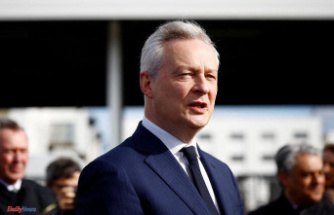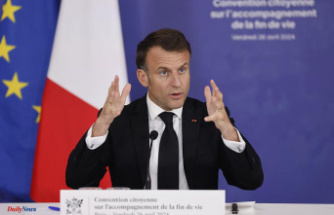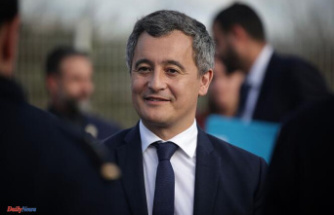In Ukraine's defensive war against Russia, there is less and less movement along the front line. Fears of a deepening trench warfare seem to be coming true. Which side is more useful is open.
The war in Ukraine has been raging for 145 days and the question is increasingly whether death and destruction will continue for months or years? There is no hope of a ceasefire or even peace within a period of weeks, as developments on the various fronts also show: There is hardly any movement left, but there are also hardly any signs of a slacking of determination on either side. Largely announced counter-offensives by Ukraine have so far had no effect, although they have succeeded in disrupting the Russian advance in the Donbass with the use of modern weapons from the West.
For Ukraine, however, even its own military successes have devastating consequences. For weeks, Russia has been fighting with the same strategy to minimize losses among its own fighters: every advance is preceded by a massive use of airstrikes, rocket fire and artillery fire. The damage to cities, settlements and infrastructure is immense. The once comparatively prosperous east of the country, with its mines and manufacturing industry, is being bombed back decades.
Especially since the Ukrainian armed forces cannot avoid reducing their own country to rubble and ashes. The Ukrainians are firing long-range western equipment deep into Russian-held territory to destroy military infrastructure and depots. According to statements by the separatists controlled by the Kremlin - which cannot be verified independently - civilians are repeatedly injured and killed. The Russian state news agency Tass distributes images and reports from the self-proclaimed People's Republics of Luhansk and Donetsk about civilian casualties from Ukrainian attacks.
In the east, a battle for the last major city in Ukrainian hands is looming: Kramatorsk. Before the war, around 160,000 people lived in the city, around 500,000 in the surrounding settlements. Long before the war, Kyiv had expanded the metropolitan area into a fortress. Its defense would probably be the last line of defense to ensure that the Donetsk Oblast, like the Luhansk Oblast, does not come under Russian control. It can be assumed that complete control of the two Donbass regions will continue to be one of Vladimir Putin's primary war goals.
It is possible that the alleged need to protect the Russian-speaking Donbass population from Ukrainian fascists justifies an advance beyond the Donbass into Ukrainian territory: According to Tass, the head of the would-be Luhansk Republic, Leonid Passechnik, spoke of a threat to Luhansk's security by the US missile system HIMARS. From the Russian point of view, a pacification and consolidation of control over the Donbass could be reason enough to shift the front even further to the west. This could include the capture of all areas east of the Dnieper River, including the major cities of Kharkiv and Poltava.
It is only a few kilometers from the front to Kramatorsk, where artillery hit this week. British intelligence and the US Institute for the Study of War expect Russian forces to approach from the east and attempt to capture Siwersk. There, the Russian army claims to have already advanced into the suburbs. Then Bakhmut could follow in the southeast of Kramatorsk and finally the city of Sloviansk. Whether and how quickly this succeeds depends on the extent to which Ukraine can disrupt Russian operations with western artillery and missile systems such as HIMARS or the Panzerhaubitze 2000 supplied by Germany and the Netherlands.
Some hopes that the Western systems could even turn the tide have so far not been fulfilled. "They only correspond to the Russian systems with a long range, but do not compensate for their numerical superiority. This results in an improvement, but not yet a decisive advantage, but at best a stalemate situation," said military expert Wolfgang Richter in an interview with ntv on Tuesday .de. Against this background, the former megacity of Kharkiv in the north-east remains threatened. The Ukrainian army has pushed back the Russian army several kilometers to the east, but the city has been bombarded from the air time and time again, and recently particularly intensely. Even the Russian artillery systems seem to have come back within range of Kharkiv.
In addition, Ukraine has to spread the western war material further: Russian forces control most of the southern regions of Cherson and Zaporizhia and from there threaten both the city of Odessa and the remaining Ukrainian coastal strip as far as Transnistria, as well as the northern cities of Zaporizhia and Dnipro. The government around President Volodymyr Zelenskyj wants to prevent a further advance by Russia in any case, which is why Zelenskyj announced a counter-offensive in the south - as long as large parts of the Russian forces are tied up in the east.
But the operation with a million Ukrainian soldiers announced by Zelenskyy has not yet been identified. "The front line is currently running between Cherson and Mykolaiv, and we will probably see some tactical changes there: local successes and failures will be recorded, a piece of land will be taken here and a piece of land will be given up there," Richter expects. But the overall situation will not change. Although Ukraine has enough personnel for an offensive, it needs more war material from the West.
With Russia it seems to be the other way around. Weapons and ammunition from Soviet times may be obsolete, but the unanimous opinion is that the stocks are "inexhaustible". The Kremlin is trying all the harder to bring personnel to the front. This week, the country's 85 regional governments have been asked to organize volunteer battalions. According to the Institute for the Study of War, around 34,000 soldiers could come together. Then there are the hundreds of thousands of reservists that Moscow can call up in the event of a mobilization.
According to many Western observers, Putin is reluctant to take this step because it would be tantamount to an admission that there is no "special military operation" going on in Ukraine, but a war with many casualties on his own side. However, on Thursday the Russian Foreign Ministry accused NATO of waging a "hybrid war" against Russia in Ukraine. Moscow could very well mobilize against a Western-imposed war.
After 20 weeks of war, there are no signs of Russia giving in, nor of Ukraine giving way. While the Kremlin is reacting with increasing irritation to the painful losses caused by Western weapon systems, Ukraine sees itself in an existential struggle against evil: this week alone, Russia shelled two civilian building complexes in eastern Chasiv Yar and the central city of Vinnytsia, killing dozens of people in each case died, including several children. Reports of rapes, kidnappings and torture in the territories occupied by Russia continue unabated.
It is unclear how long both sides can continue this war of attrition. Economically and militarily, Ukraine is completely dependent on Western support. The federal government has promised further arms deliveries, also for the reconquest of Ukrainian territory. The only thing that is unclear is where the material is supposed to come from, if not from the thin stocks of the Bundeswehr. "We must not let up in the coming weeks and months," warned Michael Roth, chairman of the Foreign Affairs Committee in the Bundestag, on ntv.de.
So far, Russia's economy has shown itself to be surprisingly resilient to Western sanctions, also because the export of raw materials continues to pour billions of euros into Putin's war chest. "We expect a sharp slump in Russia's gross domestic product and a massive increase in inflation," said State Secretary for Economic Affairs Franziska Brantner in an interview with ntv.de. However, inflation remains high and economic growth modest in the European economic area. Without Russian gas, there is even a risk of a recession. In the end, Ukraine may not fail because of its own steadfastness, but because of that of its western partners. The country will continue to fight until either Russia or the West decide to end it.












